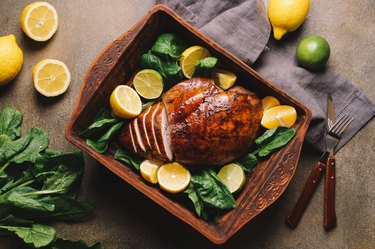
Just like whole turkeys, boneless turkey breasts come in a variety of sizes, ranging from about 2 to 3 pounds to more than 20 pounds. No matter the size, one benefit of making a turkey breast is that it takes less time to cook than a whole turkey, and you can use the leftovers for recipes for days after.
You can brine turkey legs and really any part of the bird for more flavor, but it's especially useful to brine turkey breast meat, as this part of the bird can be challenging to cook.
Video of the Day
Video of the Day
Tip
Brined turkey will cook faster than turkey that hasn't been brined, according to the National Turkey Federation.
You'll have to adjust your cooking time for brined boneless turkey breast. Check the meat for doneness with a meat thermometer. Turkey is done cooking when it reaches a safe internal temperature of 165 degrees Fahrenheit, according to USDA guidelines.
What Is a Brine?
A brine is a solution of water, salt and spices which is used to soak meats like boneless turkey breast before cooking. The brine imparts moisture and added flavor to the turkey meat, which is prone to drying out during cooking because it's so low in fat.
For best results, you should brine turkey breast for 12 to 24 hours before cooking it.
Why You Should Brine Boneless Turkey Breast
When you brine a boneless turkey breast, it helps the meat come out juicy and tender. The salt in the brine helps the liquid soak into the meat, which tenderizes it and adds moisture.
If you add other spices to your brine, the meat comes out even more flavorful. Using brine before cooking a boneless turkey breast allows you to get more creative with an otherwise bland cut of meat.
How to Brine a Boneless Turkey Breast
Things You'll Need
Bucket or stockpot
Brining bag
Saucepan
Water
Salt
Seasonings
1. Line the Container
Line your container with a brining or oven-roasting bag. The brining bag keeps the water contained and helps to prevent it from leaking in the refrigerator, making for easy cleanup. The container should be large enough to submerge the turkey breast in water; try a large stockpot or bucket.
2. Make the Brine
Pour 1 quart of water into a saucepan. Add ½ to ¾ cup of coarse salt. Salt is a key ingredient in brining, acting as both a tenderizer and a seasoning. Though salt normally draws moisture out of meat, as in a dry rub, when it's combined with water the opposite effect happens: The salt solution hydrates the turkey and helps it to retain its moisture.
3. Season the Brine
Add any additional seasonings and spices to the water that you like. Common choices are bay leaves, onion, garlic, thyme, coriander seed and mustard seed. Heat the mixture to a simmer; cook until the salt has dissolved. Remove the seasonings from heat and allow the mixture to cool for 5 minutes.
4. Brine the Turkey Breast
Place the turkey breast into the brining bag. Pour the seasoning mixture over the turkey. Cover the turkey breast completely with additional cold water.
Tie the bag so that it is securely shut. Place the pot or bucket with the turkey into the refrigerator and allow the turkey to soak in the brine for 12 to 24 hours. 12 hours is long enough to brine turkey breast, but don't brine turkey breast for too long (over 24 hours), as it may affect the quality of the meat.
5. Remove and Cook
Remove the turkey from the refrigerator and brining bag 1 hour before roasting as desired. Do not rinse your turkey after taking it out of the brine. You do not need to baste a turkey breast that has been brined, as the salt soak is usually good enough to moisten the meat.
Tip
Use a cooler if you do not have adequate space in your refrigerator to chill the turkey for 24 hours. Place the pot or bucket into the cooler and cover it with ice. Replenish the ice frequently; for food safety, the temperature in the cooler should be kept below 40 degrees.
Warning
Carefully discard the brining mixture when you are finished soaking the turkey. The seasoned water should not be used for cooking the turkey or for any other purpose.